Zhibin Hong
Texture-Preserving Diffusion Models for High-Fidelity Virtual Try-On
Apr 01, 2024Abstract:Image-based virtual try-on is an increasingly important task for online shopping. It aims to synthesize images of a specific person wearing a specified garment. Diffusion model-based approaches have recently become popular, as they are excellent at image synthesis tasks. However, these approaches usually employ additional image encoders and rely on the cross-attention mechanism for texture transfer from the garment to the person image, which affects the try-on's efficiency and fidelity. To address these issues, we propose an Texture-Preserving Diffusion (TPD) model for virtual try-on, which enhances the fidelity of the results and introduces no additional image encoders. Accordingly, we make contributions from two aspects. First, we propose to concatenate the masked person and reference garment images along the spatial dimension and utilize the resulting image as the input for the diffusion model's denoising UNet. This enables the original self-attention layers contained in the diffusion model to achieve efficient and accurate texture transfer. Second, we propose a novel diffusion-based method that predicts a precise inpainting mask based on the person and reference garment images, further enhancing the reliability of the try-on results. In addition, we integrate mask prediction and image synthesis into a single compact model. The experimental results show that our approach can be applied to various try-on tasks, e.g., garment-to-person and person-to-person try-ons, and significantly outperforms state-of-the-art methods on popular VITON, VITON-HD databases.
Masked Lip-Sync Prediction by Audio-Visual Contextual Exploitation in Transformers
Dec 09, 2022



Abstract:Previous studies have explored generating accurately lip-synced talking faces for arbitrary targets given audio conditions. However, most of them deform or generate the whole facial area, leading to non-realistic results. In this work, we delve into the formulation of altering only the mouth shapes of the target person. This requires masking a large percentage of the original image and seamlessly inpainting it with the aid of audio and reference frames. To this end, we propose the Audio-Visual Context-Aware Transformer (AV-CAT) framework, which produces accurate lip-sync with photo-realistic quality by predicting the masked mouth shapes. Our key insight is to exploit desired contextual information provided in audio and visual modalities thoroughly with delicately designed Transformers. Specifically, we propose a convolution-Transformer hybrid backbone and design an attention-based fusion strategy for filling the masked parts. It uniformly attends to the textural information on the unmasked regions and the reference frame. Then the semantic audio information is involved in enhancing the self-attention computation. Additionally, a refinement network with audio injection improves both image and lip-sync quality. Extensive experiments validate that our model can generate high-fidelity lip-synced results for arbitrary subjects.
StyleSwap: Style-Based Generator Empowers Robust Face Swapping
Sep 27, 2022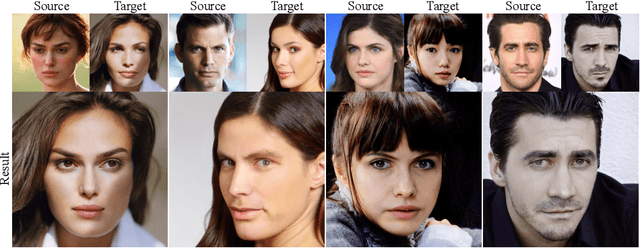

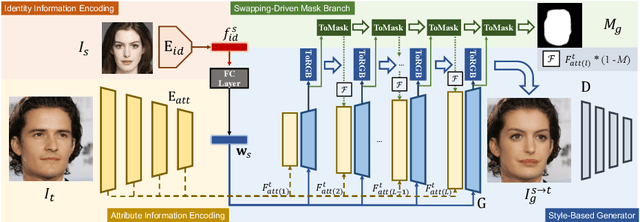

Abstract:Numerous attempts have been made to the task of person-agnostic face swapping given its wide applications. While existing methods mostly rely on tedious network and loss designs, they still struggle in the information balancing between the source and target faces, and tend to produce visible artifacts. In this work, we introduce a concise and effective framework named StyleSwap. Our core idea is to leverage a style-based generator to empower high-fidelity and robust face swapping, thus the generator's advantage can be adopted for optimizing identity similarity. We identify that with only minimal modifications, a StyleGAN2 architecture can successfully handle the desired information from both source and target. Additionally, inspired by the ToRGB layers, a Swapping-Driven Mask Branch is further devised to improve information blending. Furthermore, the advantage of StyleGAN inversion can be adopted. Particularly, a Swapping-Guided ID Inversion strategy is proposed to optimize identity similarity. Extensive experiments validate that our framework generates high-quality face swapping results that outperform state-of-the-art methods both qualitatively and quantitatively.
Delving into Sequential Patches for Deepfake Detection
Jul 06, 2022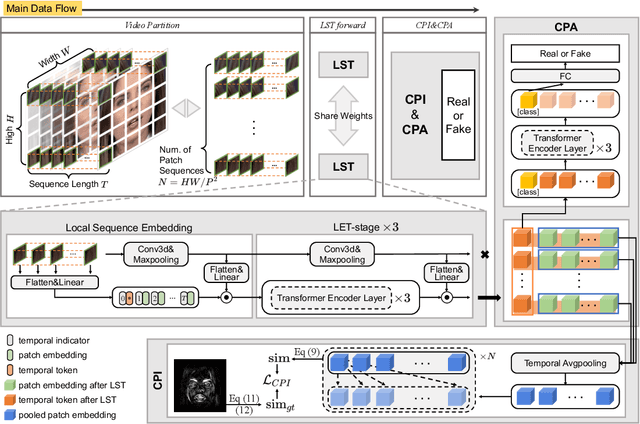
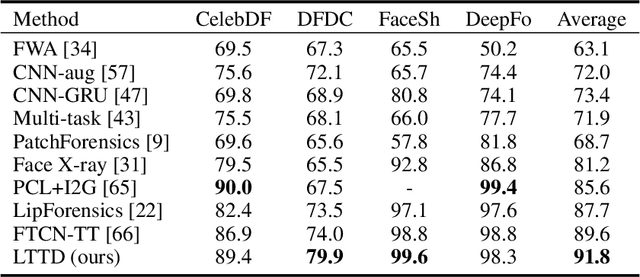
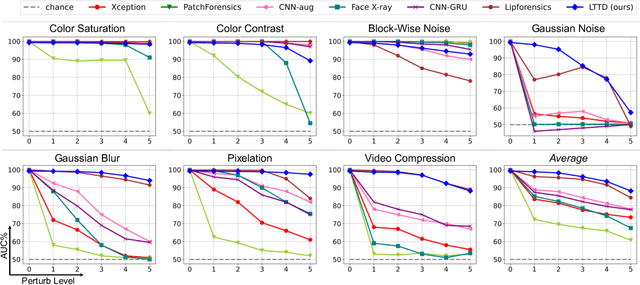

Abstract:Recent advances in face forgery techniques produce nearly visually untraceable deepfake videos, which could be leveraged with malicious intentions. As a result, researchers have been devoted to deepfake detection. Previous studies has identified the importance of local low-level cues and temporal information in pursuit to generalize well across deepfake methods, however, they still suffer from robustness problem against post-processings. In this work, we propose the Local- & Temporal-aware Transformer-based Deepfake Detection (LTTD) framework, which adopts a local-to-global learning protocol with a particular focus on the valuable temporal information within local sequences. Specifically, we propose a Local Sequence Transformer (LST), which models the temporal consistency on sequences of restricted spatial regions, where low-level information is hierarchically enhanced with shallow layers of learned 3D filters. Based on the local temporal embeddings, we then achieve the final classification in a global contrastive way. Extensive experiments on popular datasets validate that our approach effectively spots local forgery cues and achieves state-of-the-art performance.
Few-Shot Font Generation by Learning Fine-Grained Local Styles
May 23, 2022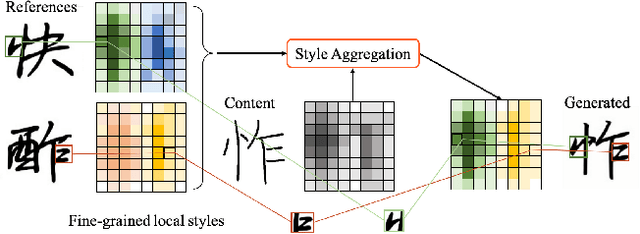
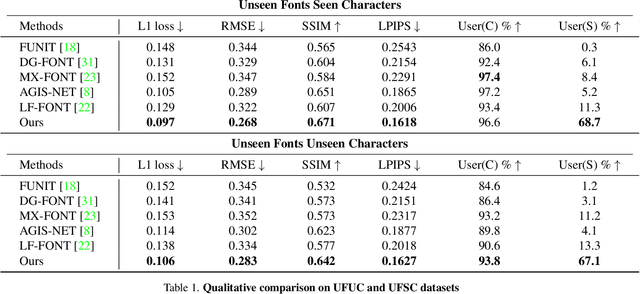

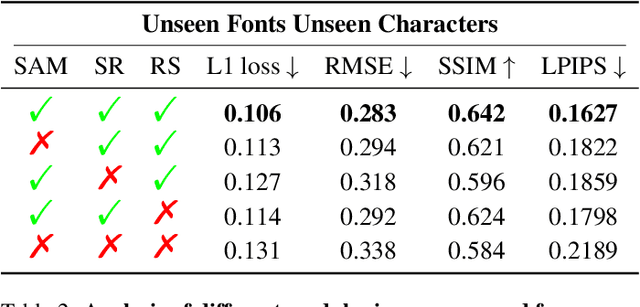
Abstract:Few-shot font generation (FFG), which aims to generate a new font with a few examples, is gaining increasing attention due to the significant reduction in labor cost. A typical FFG pipeline considers characters in a standard font library as content glyphs and transfers them to a new target font by extracting style information from the reference glyphs. Most existing solutions explicitly disentangle content and style of reference glyphs globally or component-wisely. However, the style of glyphs mainly lies in the local details, i.e. the styles of radicals, components, and strokes together depict the style of a glyph. Therefore, even a single character can contain different styles distributed over spatial locations. In this paper, we propose a new font generation approach by learning 1) the fine-grained local styles from references, and 2) the spatial correspondence between the content and reference glyphs. Therefore, each spatial location in the content glyph can be assigned with the right fine-grained style. To this end, we adopt cross-attention over the representation of the content glyphs as the queries and the representations of the reference glyphs as the keys and values. Instead of explicitly disentangling global or component-wise modeling, the cross-attention mechanism can attend to the right local styles in the reference glyphs and aggregate the reference styles into a fine-grained style representation for the given content glyphs. The experiments show that the proposed method outperforms the state-of-the-art methods in FFG. In particular, the user studies also demonstrate the style consistency of our approach significantly outperforms previous methods.
Few-Shot Head Swapping in the Wild
Apr 27, 2022



Abstract:The head swapping task aims at flawlessly placing a source head onto a target body, which is of great importance to various entertainment scenarios. While face swapping has drawn much attention, the task of head swapping has rarely been explored, particularly under the few-shot setting. It is inherently challenging due to its unique needs in head modeling and background blending. In this paper, we present the Head Swapper (HeSer), which achieves few-shot head swapping in the wild through two delicately designed modules. Firstly, a Head2Head Aligner is devised to holistically migrate pose and expression information from the target to the source head by examining multi-scale information. Secondly, to tackle the challenges of skin color variations and head-background mismatches in the swapping procedure, a Head2Scene Blender is introduced to simultaneously modify facial skin color and fill mismatched gaps in the background around the head. Particularly, seamless blending is achieved with the help of a Semantic-Guided Color Reference Creation procedure and a Blending UNet. Extensive experiments demonstrate that the proposed method produces superior head swapping results in a variety of scenes.
MobileFaceSwap: A Lightweight Framework for Video Face Swapping
Jan 11, 2022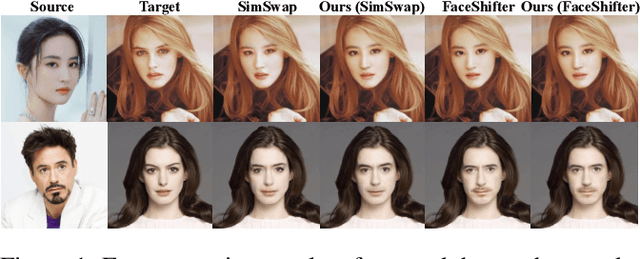



Abstract:Advanced face swapping methods have achieved appealing results. However, most of these methods have many parameters and computations, which makes it challenging to apply them in real-time applications or deploy them on edge devices like mobile phones. In this work, we propose a lightweight Identity-aware Dynamic Network (IDN) for subject-agnostic face swapping by dynamically adjusting the model parameters according to the identity information. In particular, we design an efficient Identity Injection Module (IIM) by introducing two dynamic neural network techniques, including the weights prediction and weights modulation. Once the IDN is updated, it can be applied to swap faces given any target image or video. The presented IDN contains only 0.50M parameters and needs 0.33G FLOPs per frame, making it capable for real-time video face swapping on mobile phones. In addition, we introduce a knowledge distillation-based method for stable training, and a loss reweighting module is employed to obtain better synthesized results. Finally, our method achieves comparable results with the teacher models and other state-of-the-art methods.
Quality-aware Part Models for Occluded Person Re-identification
Jan 01, 2022



Abstract:Occlusion poses a major challenge for person re-identification (ReID). Existing approaches typically rely on outside tools to infer visible body parts, which may be suboptimal in terms of both computational efficiency and ReID accuracy. In particular, they may fail when facing complex occlusions, such as those between pedestrians. Accordingly, in this paper, we propose a novel method named Quality-aware Part Models (QPM) for occlusion-robust ReID. First, we propose to jointly learn part features and predict part quality scores. As no quality annotation is available, we introduce a strategy that automatically assigns low scores to occluded body parts, thereby weakening the impact of occluded body parts on ReID results. Second, based on the predicted part quality scores, we propose a novel identity-aware spatial attention (ISA) module. In this module, a coarse identity-aware feature is utilized to highlight pixels of the target pedestrian, so as to handle the occlusion between pedestrians. Third, we design an adaptive and efficient approach for generating global features from common non-occluded regions with respect to each image pair. This design is crucial, but is often ignored by existing methods. QPM has three key advantages: 1) it does not rely on any outside tools in either the training or inference stages; 2) it handles occlusions caused by both objects and other pedestrians;3) it is highly computationally efficient. Experimental results on four popular databases for occluded ReID demonstrate that QPM consistently outperforms state-of-the-art methods by significant margins. The code of QPM will be released.
ForgeryNet -- Face Forgery Analysis Challenge 2021: Methods and Results
Dec 15, 2021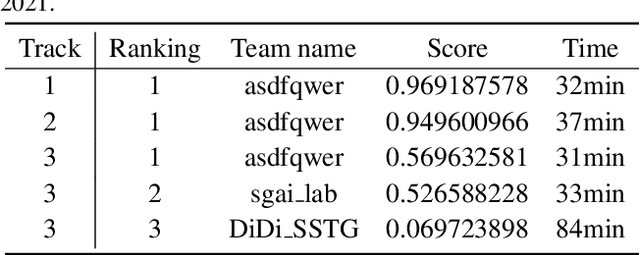
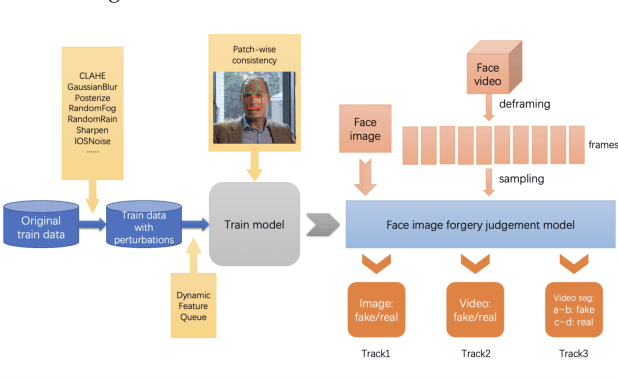
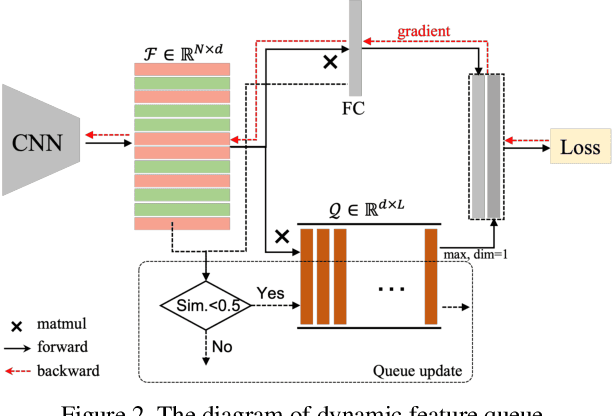
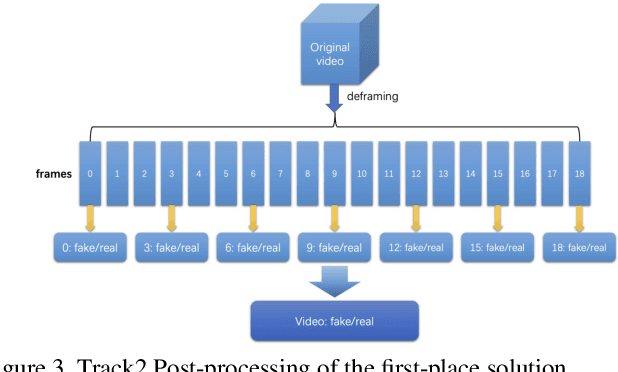
Abstract:The rapid progress of photorealistic synthesis techniques has reached a critical point where the boundary between real and manipulated images starts to blur. Recently, a mega-scale deep face forgery dataset, ForgeryNet which comprised of 2.9 million images and 221,247 videos has been released. It is by far the largest publicly available in terms of data-scale, manipulations (7 image-level approaches, 8 video-level approaches), perturbations (36 independent and more mixed perturbations), and annotations (6.3 million classification labels, 2.9 million manipulated area annotations, and 221,247 temporal forgery segment labels). This paper reports methods and results in the ForgeryNet - Face Forgery Analysis Challenge 2021, which employs the ForgeryNet benchmark. The model evaluation is conducted offline on the private test set. A total of 186 participants registered for the competition, and 11 teams made valid submissions. We will analyze the top-ranked solutions and present some discussion on future work directions.
FaceController: Controllable Attribute Editing for Face in the Wild
Feb 23, 2021
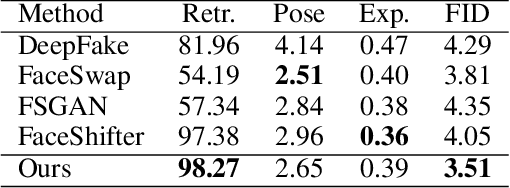

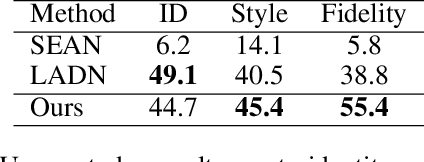
Abstract:Face attribute editing aims to generate faces with one or multiple desired face attributes manipulated while other details are preserved. Unlike prior works such as GAN inversion, which has an expensive reverse mapping process, we propose a simple feed-forward network to generate high-fidelity manipulated faces. By simply employing some existing and easy-obtainable prior information, our method can control, transfer, and edit diverse attributes of faces in the wild. The proposed method can consequently be applied to various applications such as face swapping, face relighting, and makeup transfer. In our method, we decouple identity, expression, pose, and illumination using 3D priors; separate texture and colors by using region-wise style codes. All the information is embedded into adversarial learning by our identity-style normalization module. Disentanglement losses are proposed to enhance the generator to extract information independently from each attribute. Comprehensive quantitative and qualitative evaluations have been conducted. In a single framework, our method achieves the best or competitive scores on a variety of face applications.
 Add to Chrome
Add to Chrome Add to Firefox
Add to Firefox Add to Edge
Add to Edge